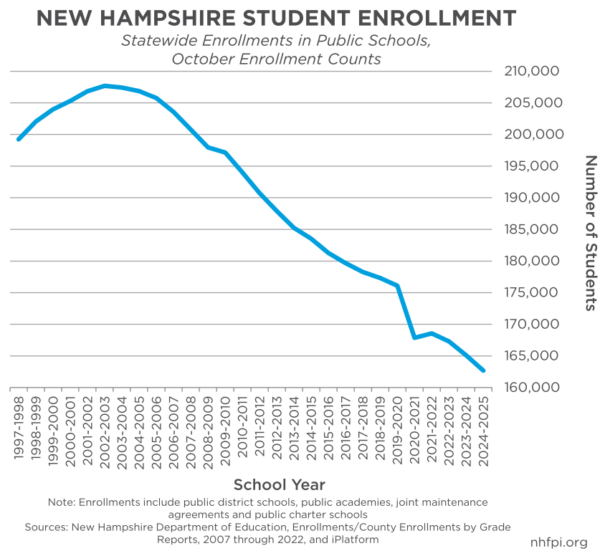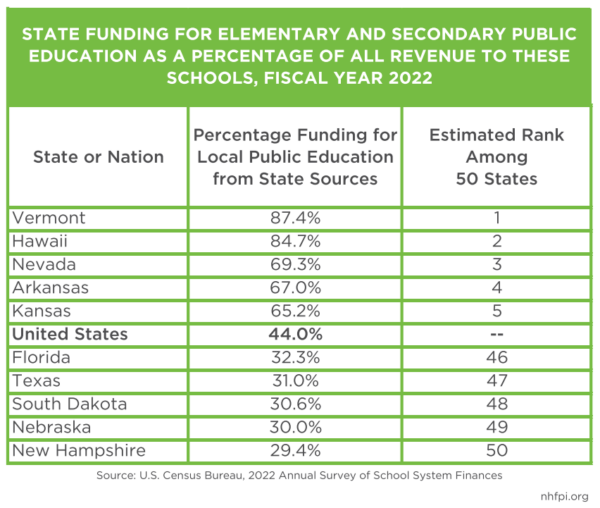This fact sheet provides a snapshot of key facts about funding education in New Hampshire.
Number of Students in New Hampshire Schools Continues to Decline
- About 45,024 fewer students were in New Hampshire public schools in the last academic year than during 2002-2003.[1]
- This reduction is driven by long-term demographic changes. New Hampshire had the largest percentage decline in its child population of any state in the country between 2010 and 2020.[2]

Local Public Education Largely Funded by Local Taxes
- Property taxes raised locally accounted for 61 percent of public school district revenue in the 2023-2024 school year.
- The Statewide Education Property Tax, which is raised and retained locally, raised $363.8 million, or about 9 percent of total school district revenue. In total, about 70 percent of local public education was funded by property taxes raised locally.[3]
- Federal aid to fund education, usually about 5 percent of school district revenue in New Hampshire, was higher due to one-time American Rescue Plan Act aid. During the 2023-2024 school year, federal sources accounted for around 9 percent of revenue.[4]
- About $350.6 million of these temporary American Rescue Plan Act funds for school districts expired on September 30, 2024.[5]
- New Hampshire ranked 9th highest among the 50 states for school revenue collected per pupil from all sources (federal, state, and local government) in fiscal year 2022. When adjusting for earned income among individuals and households in the state, New Hampshire ranked 40th, or had less revenue for public K-12 education relative to statewide income than most other states.[6]

- In 2022, New Hampshire ranked 3rd in revenue spent per pupil from local sources ($14,054), and 34th in revenue per pupil from state sources ($6,681) in the nation.[7]
- In 2022, New Hampshire spent the least amount of state funds on its public K-12 schools (as a percentage of the total revenue) of any state in the country.[8]
Higher Education Funding Lowest Among States
- New Hampshire appropriated the lowest amount of public funds per full time equivalent college student, at $4,716 each, among all fifty states in fiscal year 2023. The national average was $11,040.[9]
- While funding for the Community College System has grown faster than inflation since 2006, funding for the University System would have needed to be over $45 million higher (44 percent) than it was in State Fiscal Year 2023 to match the inflation-adjusted 2006 level.
- According to the most recently available 2020 data, graduates from New Hampshire’s four-year colleges and universities have the highest average student loan debt in the nation, at $39,950. The state ranks second in the country for the percentage of graduates with student loan debt, with about 70 percent holding debt upon graduation. Students identifying as a member of a racial or ethnic minority group experience disproportionate rates of student loan debt.[10]
- Higher education costs may be contributing to lower rates of educational attainment. Approximately 40.7 percent of New Hampshire residents had a bachelor’s degree or higher in 2023. This percentage was below several other New England states, including Massachusetts (47.8 percent), Vermont (43.7 percent), and Connecticut (42.9 percent).[11]
[1] NH Department of Education, County Enrollments by Grade Report.
[2] NHFPI, The New Hampshire Economy in 2021 and 2022, March 4, 2022, slide 29. NHFPI, New Hampshire’s Growing Population and Changing Demographics Before and Since the COVID-19 Pandemic, August 16, 2024.
[3] NHFPI, Statewide Education Property Tax Change Provides Less Targeted Relief, May 11, 2021.
[4] NHFPI, Federal American Rescue Plan Act Directs Aid to Lower-Income Children, Unemployed Workers, and Public Services, March 26, 2021.
[5] The Brookings Institution, The ESSER Fiscal Cliff Will Have Serious Implications for Student Equity, September 12, 2023. New Hampshire Office of Legislative Budget Assistant, Federal COVID-19 Funds – New Hampshire Allocations, May 1, 2023.
[6] U.S. Census Bureau, 2022 Public Elementary-Secondary Education Finance Data, Fiscal Year 2022. Washington, DC excluded from state rankings. An earlier version (January 14, 2025) of this Fact Sheet did not consistently exclude Washington, DC from these rankings.
[7] U.S. Census Bureau, 2022 Public Elementary-Secondary Education Finance Data, Fiscal Year 2022.
[8] U.S. Census Bureau, 2022 Public Elementary-Secondary Education Finance Data, Fiscal Year 2022.
[9] State Higher Education Finance Report, Education Appropriations and Net Tuition Revenue, Figure 2.3.
[10] See the Institute for College Access and Success’ Student Debt and the Class of 2020 (November 2021), Table 3: Percentage of Graduates with Debt and Average Debt of Those with Loans, by State.
[11] U.S. Census Bureau, American Community Survey, Table S1501.
